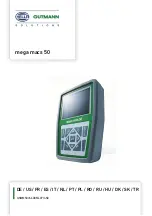
A. Tang/Conductor Tab
Tang/conductor tab electrically
connects the circuit breaker to
the CPOD. In order to secure the
connection of CPOD to the breaker,
the tang needs to be inserted
into the load lug of the circuit
breaker and tightened to torque
requirements found on the circuit
breaker labeling.
B. Mechanical Status Indicator
The status indicator is used to
convey the current state of the
CPOD contacts, open or closed
position. This feature is visible
through the round-hole opening
on the dead front provided for each
circuit. The color definitions are as
follow:
"Green - CPOD contact
is in "OPEN" or "OFF"
position
"Clear - CPOD contact is in
"CLOSED" or "ON" position.
C. Manual Override
Manual override is a feature of the
CPOD that provides the customer
the ability to override the remote
commands to the CPOD. The contact
on the CPOD can be forced to a
closed position by manually rotating
the switch in clock-wise direction
using a flat-head screwdriver or
similar device as shown in figure 6.7
below. To re-open contacts, system
must be commissioned. This feature
is designed to apply current on the
circuit prior to commissioning system.
D. CPOD Load Lug
The CPOD load lug has the same
form and appearance as the BQD
circuit breaker load lug. The torque
requirements can be found on the
circuit breaker labeling. For electrical
load wiring information, refer to
Breaker rating label located on the
face of the breaker.
E. CPOD Connector
CPOD connector is a 4-pin connector
that connects CPOD to data rail.
CPOD connector has to be connected
to the data rail connector to enable
the communication between CPOD
and i-3 controller.
Chapter 6
System Components
Manual
Override
Switch
Figure 6.7
Manual Override Switch
19















































